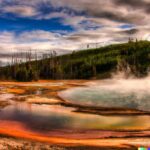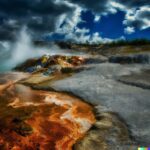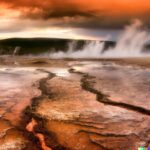Yellowstone National Park is famous for its stunning natural geysers, with many of them being highly acidic. In this article, we will explore the unique characteristics of acidic geysers, including their temperature, pH levels, and the minerals they contain.
We will also take a closer look at some of the most famous acidic geysers in Yellowstone, such as Old Faithful Geyser and Grand Geyser. We will discuss the potential dangers of these geysers and provide tips for safely viewing them during a visit to Yellowstone National Park. If you’re curious about the fascinating world of acidic geysers, keep reading to learn more!
What Are Geysers?
Geysers are fascinating natural features that result from the thermal and volcanic activity within the Earth’s crust.
Geysers are characterized by intermittent hot water and steam eruptions, often accompanied by a distinct hissing sound.
The formation of geysers is a complex process, typically occurring in areas with high geothermal activity, where water seeps deep into the ground and encounters hot rocks.
As the water is heated by the Earth’s geothermal energy, pressure builds up until it eventually erupts out of the earth’s surface.
Geysers are significant as they offer a glimpse into the powerful forces at work beneath the Earth’s surface and are cherished as unique natural wonders.
Where is Yellowstone National Park?
Yellowstone National Park, located primarily in the U.S. state of Wyoming, is a renowned destination for tourists, offering unique landscapes and remarkable geological formations.
The park’s diverse ecosystems are home to an array of wildlife, including bears, wolves, elk, and bison, adding to the allure for nature enthusiasts.
Visitors are drawn to its iconic geothermal features, such as the Old Faithful geyser, as well as the colorful hot springs and bubbling mud pots. Its vast forests, expansive meadows, and majestic canyons further contribute to the park’s natural beauty and appeal.
There are numerous hiking trails, camping grounds, and scenic drives for visitors to explore and immerse themselves in the park’s breathtaking scenery.
What Makes Yellowstone Unique?
Yellowstone stands out for its exceptional geothermal features, including geysers, volcanic landscapes, and extreme environments that support unique ecosystems.
How Many Geysers Are Found in Yellowstone?
Yellowstone National Park is home to an impressive number of geysers, showcasing the park’s volcanic features and thermal pools.
Yellowstone National Park is home to some of the most impressive geysers in the world, including the iconic Old Faithful. These geysers are a result of the park’s unique geological conditions, shaped by underlying volcanic activity. The result is a breathtaking landscape filled with vibrant thermal pools and mesmerizing steam vents.
Visitors to the park can witness the raw power of these geysers as they erupt with scalding water and steam, adding an exhilarating dimension to the park’s natural wonders. The interconnected network of geysers and thermal features in Yellowstone offers a glimpse into the Earth’s dynamic and ever-changing processes, making it a must-visit destination for nature enthusiasts and geology aficionados alike.
What Causes Acidic Geysers at Yellowstone?
The formation of acidic geysers at Yellowstone is primarily attributed to the presence of sulfur and other hydrothermal features, thriving in extreme conditions unique to the area.
Extreme conditions, such as high temperatures and pressure, are responsible for the creation of acidic geysers. The thermal waters contain sulfur compounds, which contribute to the formation of sulfuric acid and increase the acidity of the geysers. As the hot water interacts with the surrounding rocks, minerals are leached, giving the geysers their distinct colors and acidic composition. This combination of factors results in the extraordinary and one-of-a-kind environment found at Yellowstone National Park.
What Are the Characteristics of Acidic Geysers?
Acidic geysers in Yellowstone exhibit a unique environment that supports heat-loving organisms, characterized by extreme conditions and distinct geological features.
How Hot Are Acidic Geysers?
Acidic geysers at Yellowstone reach extreme temperatures, fueled by the circulation of hydrothermal fluids within the geothermal system.
The intense heat generated by these acidic geysers is a result of the interaction between the geothermal system and the hydrothermal fluids. These geysers act as natural manifestations of the underground heat, releasing bursts of steam and boiling water.
The extreme temperatures, often exceeding 200°F, showcase the dynamic nature of Yellowstone’s geothermal features. The high acidity of these geysers adds an additional layer of complexity, reflecting the powerful geological processes at work beneath the Earth’s surface.
What Minerals Are Found in Acidic Geysers?
Acidic geysers are known to harbor diverse mineral deposits, reflecting the complex water chemistry inherent to these hydrothermal features.
Acidic geysers are shaped by minerals like silica, sulfur, and metal sulfides. The water chemistry and mineral composition have a close connection, influencing the vibrant colors and intricate formations found around these hydrothermal features.
The minerals found in acidic geysers offer valuable insights into the geochemical processes happening deep within the Earth’s crust. This highlights the dynamic nature of these captivating natural wonders.
What Is the pH Level of Acidic Geysers?
The pH level of acidic geysers is notably influenced by the presence of sulfuric acid and the intricate water chemistry at play within these hydrothermal systems.
This unique environment creates a delicate balance where the interaction between acidic fluids and the surrounding rock formations leads to the release of various compounds, further shaping the water’s pH.
The high concentration of sulfuric acid in these geysers contributes significantly to their low pH levels, resulting in the distinctively acidic nature of their waters. Understanding the complexities of water chemistry in these hydrothermal systems is crucial for researchers and geologists to comprehend the ecosystem’s intricacies and the potential impact on surrounding environments.
What Are the Most Famous Acidic Geysers at Yellowstone?
Yellowstone boasts several famous acidic geysers, including the iconic Old Faithful, the majestic Grand Geyser, the impressive Castle Geyser, and the vibrant Morning Glory Pool.
Yellowstone National Park is home to several unique geysers, each with its own distinct characteristics. Old Faithful is renowned for its regular eruptions, while Grand Geyser impresses visitors with its massive and forceful displays. Castle Geyser, with its castle-like structure, is known for its unpredictable eruptions, and Morning Glory Pool mesmerizes onlookers with its vivid blue and green hues.
These geysers are a major draw for tourists, adding to the park’s charm and appeal. They contribute to the diverse and captivating geothermal landscape of Yellowstone, making it a must-visit destination for nature lovers.
Old Faithful Geyser
Old Faithful Geyser at Yellowstone captivates visitors with its spectacular, predictable eruptions, standing as one of the park’s geological wonders.
Visitors marvel at the regularity of its eruptions, occurring approximately every 90 minutes. The geyser reaches heights between 100-180 feet, unleashing powerful streams of boiling water and steam.
As one of the most predictable geysers globally, its reliability adds to the allure, drawing crowds who eagerly anticipate its next display. Its unique combination of accessibility, beauty, and frequent eruptions cements Old Faithful Geyser‘s reputation as a must-see natural wonder at Yellowstone.
Grand Geyser
The Grand Geyser is renowned for its impressive eruptions and its role in shaping the geothermal features and geologic formations of Yellowstone.
Witnessing the Grand Geyser’s eruptions is a thrilling sight. It propels water and steam high into the air, creating a mesmerizing display that captivates visitors.
The geyser’s eruptions can reach over 200 feet in height, making it one of the tallest predictable geysers in the world. This natural spectacle not only showcases the incredible power of geological forces but also plays a significant role in contributing to the unique landscape and geological formations found within Yellowstone National Park.
Castle Geyser
Castle Geyser stands out for its mineral-rich waters and its influence on the surrounding hydrothermal ecosystem within Yellowstone.
The mineral-rich waters of this geyser are famous for their vibrant colors, ranging from orange to deep green. These hues are a result of the presence of minerals like sulfur and arsenic.
The geyser’s eruptions forcefully propel these mineral-rich waters through channels and into surrounding hydrothermal features, creating a mesmerizing spectacle. This infusion of minerals has a profound impact on the adjacent ecosystem, influencing the growth of unique microbial communities and contributing to the formation of captivating terraces and formations.
Morning Glory Pool
Morning Glory Pool is renowned for its vibrant colors, hosting diverse microbial life in an extreme habitat within Yellowstone National Park.
The striking hues of the pool, ranging from deep blue to fiery orange, are a result of the presence of complex thermophilic microorganisms. These microbial communities thrive in the scalding temperatures of the pool, creating a mesmerizing display of colors.
The pool’s extreme conditions create a unique environment, allowing for the coexistence of a multitude of microbial species, making it a fascinating subject for scientific study and a captivating sight for visitors.
What Are the Dangers of Acidic Geysers?
The dangers associated with acidic geysers include the potential for geothermal explosions, presenting notable environmental challenges within Yellowstone.
Geysers are known for their ability to emit high levels of toxic gases and chemicals, posing a threat to both the surrounding ecosystems and human health. The acidic nature of these geysers makes them even more volatile, increasing the risk of sudden eruptions that could cause widespread damage and release hazardous materials. To manage and mitigate these risks, comprehensive monitoring and preventive measures are necessary to ensure the safety of the area and its inhabitants.
How Can Visitors Safely View Acidic Geysers at Yellowstone?
Visitors to Yellowstone can safely view acidic geysers by following designated paths and guided tours, experiencing the park’s geothermal exploration and natural attractions with expert guidance.
This approach ensures that visitors can fully appreciate the unique and powerful natural phenomena while minimizing any potential risks associated with the geothermal features.
By staying on the designated paths, visitors not only protect themselves but also contribute to the preservation of the delicate ecosystem that surrounds the geysers.
Following a guided tour enhances the experience by providing in-depth knowledge about the geological significance and historical context of these fascinating natural wonders.
The park’s commitment to promoting responsible exploration allows for an enriching and safe visit for all who come to observe the magic of Yellowstone’s acidic geysers.
Frequently Asked Questions
What are acidic geysers at Yellowstone features?
Acidic geysers at Yellowstone features are hydrothermal features, such as geysers and hot springs, that have a low pH level due to the presence of sulfuric and other acidic compounds.
How are acidic geysers formed at Yellowstone?
Acidic geysers at Yellowstone features are formed when rain and snow melt seep through layers of rocks and minerals containing sulfuric compounds. These compounds react with the water, creating acidic conditions in the hydrothermal features.
Are acidic geysers harmful to visitors?
Yes, acidic geysers at Yellowstone features can be harmful to visitors if they come into direct contact with the acidic water. It is important to follow designated paths and warning signs to avoid any potential harm.
What is the color of acidic geysers at Yellowstone features?
The color of acidic geysers at Yellowstone features can vary, but they often have a milky or cloudy appearance due to the presence of sulfuric compounds. Some may also have a yellow, green, or orange color due to the presence of different types of bacteria and algae.
Can animals survive in the acidic geysers at Yellowstone features?
No, animals are unable to survive in the acidic geysers at Yellowstone features due to the extreme conditions. The acidic water and high temperatures make it difficult for any living organisms to survive.
Can acidic geysers at Yellowstone features change over time?
Yes, acidic geysers at Yellowstone features can change over time due to factors such as weather patterns, volcanic activity, and human interference. This can cause changes in the pH levels and appearance of the features.
Last Updated on February 7, 2024 by Jon Waraas – Originally Posted: January 25, 2024

I’m Jon Waraas, and I’ve been navigating the online world since 2006. By day, I’m the proud owner of some eCommerce gems, and by night, I’m the voice behind the adventures on Waraas.Com.
My heart, however, belongs to the wild beauty of Yellowstone National Park. I’ve got a collection of websites dedicated to sharing the wonders of this natural masterpiece. Oh, and did I mention? I’m currently building my own cabin inside the ghost town of Gilmore, Idaho – a cabin with tales to tell!
When I’m not immersed in the digital realm, you’ll find me lacing up my boots for a good hike or setting up camp under the star-studded sky.




